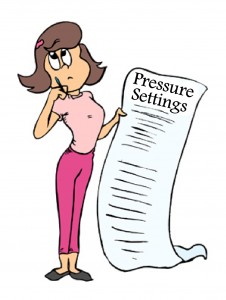
Spring isn’t here yet, but if you saw my closet you would all be telling me, “Tatum, it’s time to do some spring cleaning”! The problem is that as soon as I throw something away, it’s just a few short weeks or days later that I need it again. This happens with clothes, recipes, newspapers, you name it — I hate throwing things away but I struggle to keep it all organized! In my attempt to do some spring cleaning on my computer here at work, I was able to find a document on the pressure settings that I use for specific materials. I was also pleasantly surprised when Amanda pointed out to me that we have a similar document with many more materials and they are all neatly organized. I feel this is noteworthy to point out to our newbies as well as our golden oldie Inspiration users who may not realize we have it! So here’s a tip that keeps everything organized, and makes for a quick easy reference later on: Print off this document and place it in the back of your manual. You might find that some of the settings you’re using work better than the ones provided here an that’s okay!! Every machine is different and what settings work well for someone else might not be the right fit for you, but at least you have a reference guide that gives you a good starting point. There’s no point in cutting vinyl at a pressure of 40 or chipboard at a pressure of 2. This helps to give you a better idea where to “begin” adjusting your settings and what we’ve found to be the most successful.
Now I suppose I can throw away my old document away and use this new, already organized, and more complete pressure guide!
Click here for a list of recommended pressure settings


I have this document and always use it as a starting point. As you have said, every machine is different. There are times I have to make minor adjustments to get better cuts. The above chart helps by giving a reference point to tweak just a bit up or down to get the best cut. Over the years, I have collected such a stash of paper that I have no idea where some of the papers came from. Although by feeling the paper, fiberous, thickness, texture, etc. . . you have an idea at what point to tweak following the provided chart above.
I too had this chart and agree with Linda about making some adjustmments on occasion. I had even laminated mine when I first started using my pazzle to have it handy.
Thank you for this. A great reference.